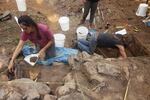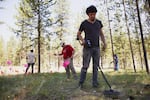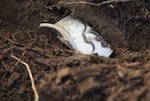It was the kind of July day in Eastern Oregon when the dusty air waits for a spark to ignite a fire. In fact, two fires were already burning nearby.
Chelsea Rose, clad in black jeans, a black woven cowboy hat and black leather combat boots, was leading a team of U.S. Forest Service employees, archaeologists and volunteers through the backwoods. Two-way radios crackled with fire spotters’ updates. Although the fires were still a distance away, another could have started at any minute. Everyone needed to be prepared to evacuate.
Rose stepped over felled logs and rutted ground. Piles from a forest thinning operation were scattered throughout the landscape. There was no trail, but Rose didn’t need it — she spotted a small, unassuming depression in the ground.
“It’s a mining ditch, an aqueduct,” said Rose, an archaeologist from Southern Oregon University. She turned to follow it after pointing out a large reservoir and a bump in the aqueduct that probably held a gate. Moving water, Rose said, was crucial for gold mining operations. Hand-built aqueducts like this one could stretch for miles, descending steadily across a mountainside.

Archaeologists excavate the hearth from a Chinese gold miners' cabin in the Malheur National Forest.
Erin Ross / OPB
The people who created them are almost certainly dead, but only recently. Many of their children are still alive.
Rose works on the Oregon Chinese Diaspora project. She studies the mass immigration of Chinese workers into Oregon, many of who came as miners when Gold Fever hit Oregon in the mid 1800s. At one point, 40% of the residents of Grant County, where Rose is currently excavating, were Chinese.
“If you look at the population of Chinese residents [in Grant County], in the 1860s up through the turn of the century, there would be a lot of folks here,” Rose said. “There’s not now, and there’s a reason for that.”
The reason is the Chinese Exclusion Act, an 1882 law that prohibited the immigration of Chinese workers to the United States. It was the first law ever passed that was aimed at blocking a specific ethnic group's entry into the U.S.
Their mining claims were taken. Their property was seized and they were prohibited from purchasing new property. Their towns and neighborhoods were torn down. Many moved to urban centers and many more moved back to China. Chinese Americans became a footnote in Oregon’s history books.

Looters scattered artifacts throughout an archaeological site in Malheur National Forest.
Erin Ross / OPB
Just because history is recent, doesn’t mean it’s remembered.
But if you know where to look — and Rose does — you can see evidence of Chinese influence all over Oregon. Chinese immigrants built the railroads. Their mines helped prop up the economy of Oregon. They worked in canneries and hop farms. They even changed the shape of the land they lived on, in dramatic ways.
“We have very little that comes from Chinese residents themselves,” Rose said. “Archaeology is a way to capture that. The artifacts we find in the dirt? They tell stories about choices and opportunities.”
Eventually, Rose followed the aqueduct to the site of an old mining cabin. A few rotting logs remained in a rough square shape. The site had been disturbed — probably by looters — so artifacts like glass, cans, nails and bits of shovel were strewn throughout the area.
This site was just for show. The actual excavation was taking place a quarter-mile away, but here, Rose’s volunteers could see snippets of the sorts of things they might find: glass stamped with symbols that link them to companies in China, pieces of pottery, tins of food repurposed as sieves, water filters, and mining tools.
When they arrived at the actual site, the excavation began. It was less Indiana Jones and more a meticulous documentation of each and every object in the area.

Volunteers sweep the ground with metal detectors, marking each hit with a colored flag. GPS coordinates will be taken for each.
Erin Ross / OPB
Rose’s volunteers spread out, marking the location of every surface artifact with a flag. Then, they took metal detectors and placed a flag everywhere there was a beep. Eventually, the ground was covered with orange and pink flags fluttering in the dry wind.
Rose and a collaborator moved from flag to flag, logging the GPS location of each artifact before they ever began excavating. It took all day.
The next day, they dug, excavating precisely marked square plots. Anything the team found, they documented, photographing it in the ground before they removed it from the plot. Dirt was carefully scraped and brushed from the plot, layer by meticulous layer, and placed into buckets. Those buckets were then sifted through window screens to reveal even tinier artifacts.
Eventually, a portrait of a life revealed itself.
Katie Johnson, an archaeologist and GIS specialist on Rose’s team at Southern Oregon University, has been documenting pieces of glass bottles found in a hearth.
“He had a lot of different oils and sauces,” she said. “And some of these, I think, might have had alcohol?”
You can learn a lot about a person if you learn how they cooked.
Over the course of a week, Rose excavated a number of sites. Each piece, carried thousands of miles across the sea, and from there through inhospitable Oregon desert, can tell a story.
“We’re looking at the types of things you would bring with you if you left home. Like, they answer, ‘What does home mean?’” Rose said, holding up a small piece of blue-green china. “We find these breakable heavy tea pots that are just beautiful things that someone carried with them.”

Miners would have brought pots like this with them when they traveled from China. The pots are delicate, and a lot of work to bring and maintain, but pieces of home were highly valued.
Erin Ross / OPB
It’s those fragments of home that tell you who used to live there.
They find pieces of bone china: cups and plates and teapots. But not all of these artifacts are eye-catching; some look like trash, something discarded along the road. But the empty cans and food containers from midden piles can tell an archaeologist even more about how someone actually lived. Was the can cut open with a knife or just punctured? That can tell a researcher if it was used to store a liquid, or something large, like pears.
The most striking site had a massive stone wall, the remains of a hearth with the bones of animals the residents ate. To the side were a pair of rubber boot soles studded with nails — hob-nails — that Chinese miners would push through the soles of their shoes for traction.
These miners came from subtropical areas, Rose said, but they would mine all through the cold Blue Mountain winters, standing knee-deep in frigid water while they worked. The boots kept their feet warm and dry. They were lovingly cared for, probably carried by their owner over hundreds of miles. They were all that stood between the miners and frostbite.
There's an urgency to the work Rose and her colleagues are doing in the Malheur National Forest. The threat of wildfire is always present and it's getting worse. The already fire-prone stands of ponderosa pine trees are under threat as human-caused climate change makes wildfires bigger, hotter and more frequent.
A grant to the Forest Service aims to mitigate those wildfires by thinning parts of the forests and doing controlled burns.

Jane Collier, a volunteer, sifts dust and sand through a screen. Any artifacts larger than 1/4 inch by 1/4 inch will get stuck in the screen, and catalogued.
Erin Ross / OPB
Don Hann, the heritage program manager with Malheur National Forest, said the Forest Service is obligated to protect any archaeological sites on its land.
“But we’re talking about tiny pieces of clothing, milled wood, pieces of leather and rubber," Hann said. "Any fire, even a small one, can destroy all that history.”
The race against time is two-fold: These sites need to be documented before they’re burned away. And they need to be located before they’re destroyed by thinning operations.
Related: Massacre At Hells Canyon
There’s a problem, though. There are no reliable records of the locations of Chinese mines. After the Exclusion Act, many worked off-the-books. But a few years ago, as part of a program to identify areas that are likely to burn in a wildfire, the Forest Service used a low-flying plane to get LIDAR images of the area. LIDAR is an imaging technology that maps the ground with incredible accuracy, catching differences in elevation of just a few inches.
For archaeologists, that’s all they need. Because the Chinese miners did more than dig for gold: they shaped the landscape. Their aqueducts crisscrossed the mountains for miles. They constructed reservoirs that held and released water in the driest parts of summer. They built streams where there were none, and the massive rock piles left behind after excavations, called tailings, formed mounds as well as deep, miles-long ditches.
“Before, we thought we had maybe 1,000 to 2,000 acres of mining area. Now we’re looking at 7,000 to 8,000,” Hann said.
In recent years, a lot of misconceptions about the Chinese in Oregon have been corrected — the extent of the mining operations, who was running the mines. And even when historians began to acknowledge the role the Chinese played in Oregon mining, Hann said many still assumed that Chinese miners were laborers working for white-owned mining companies. But that wasn’t the case.
They ran their own companies, and as many as 70% of the miners in the area could have been Chinese.
“The fact that these populations aren’t represented now means that it’s even more important for us to understand their historical contribution and acknowledge it,” Rose said. “That’s how we can start to own up, and make up for the wrongs that were done to these early immigrant populations.”

A can repurposed to use as a sieve
Erin Ross / OPB
Despite all those barriers, though, Chinese people thrived for a time in Oregon. They built infrastructure, established communities and funneled gold into the economy. And then, a suite of policies, targeting one ethnic group, erased much of their history.
Racism and animosity did the rest. But it doesn’t change their presence.
They lived and worked and made friends and built lives, Rose said.
“Their stories deserve to be told.”